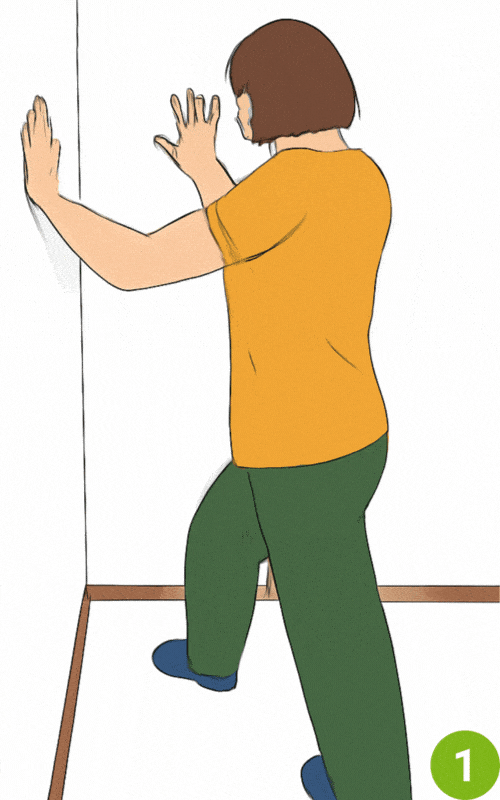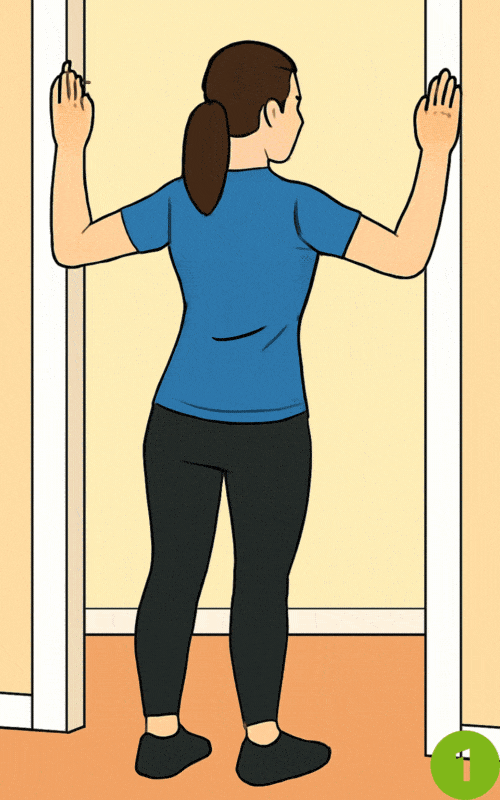If you’ve been dealing with rounded shoulders, nagging shoulder pain, or tightness in your chest region — it could all trace back to one culprit: your tight pectoralis minor muscle, which can often be relieved with a targeted pec minor stretch.
Most people don’t even realize how much tension is stored in this small, deep chest muscle, hidden beneath the pectoralis major [1].
But the effects of a tight pectoralis minor ripple across your shoulders, neck, and even down your arms.
Ready to unlock better posture and then banish discomfort? Let’s dive into the best pectoralis minor stretch that gets real results — fast.
3 Effective Stretches for a Tight Pectoralis Minor Muscle
Here are three powerful stretches to release your pectoralis minor [2] and then restore shoulder mobility.
1. Supine Manual Pec Minor Stretch

- Lie on your back on the floor with your knees bent and then feet flat on the floor.
- Maintain good alignment with your upper body.
- Place a small rolled towel or foam roll under your upper thoracic spine and then place one arm overhead.
- After that, contract your abdominal muscles.
- Reach your arms overhead and let them fall open naturally.
- Hold for 1–2 minutes, focusing on slow breaths.
2. Doorway Pec Minor Stretch

- Begin in an upright standing position on a doorway with your feet hip-width apart, maintain good alignment with your head, shoulders, hips and then legs.
- Place your forearms on the wall with your elbow bent at 90 degrees and aligned with shoulder height.
- Engage your core muscles and then move your upper body forward, leaning into the stretch and squeezing your shoulder blades together.
- After that, hold the position for a couple of seconds.
- Relax and then repeat the movement with 5 repetitions.
3. Wall Corner Pec Major + Minor Combo Stretch

- Begin in an upright standing position in front of a wall corner.
- Step one foot forward as you place your hands on the wall.
- Engage your core muscles, then lean into the wall, keeping your elbows and forearms in place.
- Slowly shift your chest forward while keeping your spine neutral.
- You’ll feel this in both your pectoralis major and pectoralis minor muscles.
- Hold the position for a couple of seconds and then repeat the movement on the opposite leg.
How to Do the Pec Minor Stretch (Step-by-Step)
This stretch adds a twist to the classic doorway stretch to give you a deeper stretch that targets the elusive pec minor muscle.
1. 90-90 Doorway Stretch with a Twist

- Begin in an upright standing position on a doorway with your feet hip-width apart, maintain good alignment with your head, shoulders, hips, and then legs.
- Place your forearms on the wall with your elbows bent at 90 degrees and aligned with shoulder height.
- After that, step forward with your left foot.
- Engage your core muscles, then twist your upper body to the right side while keeping your hips straight.
- Hold the position for a couple of seconds.
- Relax and repeat the movement on the opposite side.
Tip: To enhance the stretch, place a foam roller along your thoracic spine between the shoulder blades before or after stretching
The Sneaky Effects of a Tight Pec Minor
When the pec minor is tight, it pulls the shoulder blade forward and downward, contributing to rounded shoulders and potentially compressing nerves that run into the arm.
Common symptoms of a tight pectoralis minor include:
- Persistent shoulder pain
- Tingling or numbness in your arm
- Neck tightness
- A forward head or hunched posture
- Clicking or pinching sensations from subacromial impingement
This tightness also leads to altered scapular kinematics, meaning the shoulder blade’s movement patterns become dysfunctional.
This throws off the delicate rhythm between the scapula, pec muscles, and back muscles like the trapezius and levator scapulae.
Over time, it can affect everything from arm strength to breathing due to its influence on the rib cage.
Pro Insight: Why You Must Stretch the Pec Minor
Ignoring the pectoralis minor leads to a chain reaction of dysfunction.
You might foam roll your back or do shoulder exercises, and still feel stuck, because the tight pec minor is the missing link.
Stretching this small but critical chest muscle improves:
- Scapular kinematics [3] (how your shoulder blades move)
- Posture and appearance
- Range of motion for lifts and daily movement
- Reduction in neck and shoulder tension
- Prevention of subacromial impingement and nerve pain
When to Seek Professional Advice
If your symptoms include persistent numbness, discomfort even after stretching, or pain interfering with sleep or activity, consult a body movement therapy professional.
They can assess your posture, shoulder blade mechanics, and deeper muscle imbalances.
Final Thoughts: Don’t Skip This Forgotten Muscle
Your pectoralis minor might be hidden beneath the pectoralis major, but ignoring it can sabotage your shoulder health, posture, and comfort.
Incorporate these three stretches into your daily routine to relieve tension, improve symptoms, and take the pressure off your neck, shoulders, and upper chest.
It’s time to stretch smarter, not harder.
Discover fast, effective relief with Shoulder Pain Solved — your step-by-step solution to stronger, pain-free shoulders. Regain your mobility, boost your strength, and enjoy life again.
Frequently Asked Questions
How do you release a pectoralis minor?
You can release the pec minor through stretching, self-myofascial release (e.g., with a lacrosse ball), manual therapy, or targeted exercises like doorway or corner pec stretches.
What causes the tight pec minor?
Common causes include poor posture (especially forward head and rounded shoulders), overuse from activities like bench pressing, or prolonged sitting and slouching.
Do dips stretch the pec minor?
Not effectively. Dips primarily target the pec major, triceps, and anterior deltoid. They may actually tighten the pec minor if shoulder positioning is poor.


